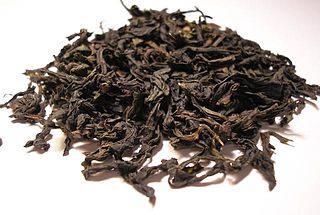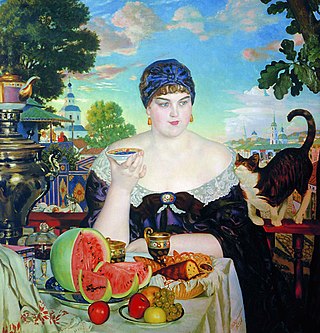Related Research Articles

Smoking is the process of flavoring, browning, cooking, or preserving food by exposing it to smoke from burning or smoldering material, most often wood. Meat, fish, and lapsang souchong tea are often smoked.

A camel train, caravan, or camel string is a series of camels carrying passengers and goods on a regular or semi-regular service between points. Despite rarely travelling faster than human walking speed, for centuries camels' ability to withstand harsh conditions made them ideal for communication and trade in the desert areas of North Africa and the Arabian Peninsula. Camel trains were also used sparingly elsewhere around the globe. Since the early 20th century they have been largely replaced by motorized vehicles or air traffic.

Lapsang souchong or Zhengshan xiaozhong is a black tea consisting of Camellia sinensis leaves that may be smoke-dried over a pinewood fire. This smoking is accomplished either as a cold smoke of the raw leaves as they are processed or as a hot smoke of previously processed leaves. The intensity of the smoke aroma can be varied by locating the leaves closer or farther from the source of heat and smoke or by adjusting the duration of the process. The flavour and aroma of smoked lapsang souchong is described as containing empyreumatic notes, including wood smoke, pine resin, smoked paprika, and dried longan; it may be mixed with milk but is not bitter and usually not sweetened with sugar. The tea originates from the Wuyi Mountains region of Fujian and is considered a Wuyi tea. It is also produced in Taiwan. It has been labelled as smoked tea, smoky souchong, tarry lapsang souchong and lapsang souchong crocodile. While the tea leaf grading system adopted the term souchong to refer to a particular leaf position, lapsang souchong may be made with any leaf of the Camellia sinensis plant, though it is not unusual for the lower leaves, which are larger and less flavourful, to be used as the smoking compensates for the lower flavour profile and the higher leaves are more valuable for use in unflavoured or unblended teas. In addition to its consumption as a tea, lapsang souchong is also used in stock for soups, stews and sauces or otherwise as a spice or seasoning. Beginning in the early 21st century, an unsmoked variety of lapsang souchong was developed in the village of Tong Mu Guan in the Wuyi mountains. The unsmoked variety has become increasingly popular, particularly in the Chinese domestic market.

Earl Grey tea is a tea blend which has been flavoured with oil of bergamot. The rind's fragrant oil is added to black tea to give Earl Grey its unique taste. However, many if not most Earl Greys use artificial bergamot flavour.
Prince of Wales tea blend is a blend of Keemun tea, gunpowder green tea, and a dash of currant juice or infused with dried currants. This produces a full-bodied cup with a bright liquor and strong aroma. It was named after Edward, Prince of Wales, who held that title from 1911 until 1936.

Keemun is a famous Chinese black tea. First produced in the late 19th century, it quickly became popular in the West and is still used for a number of classic blends. It is a light tea with characteristic stone fruit and slightly smoky notes in the aroma and a gentle, malty, non-astringent taste reminiscent of unsweetened cocoa. Keemun is said to have floral aromas and wooden notes.

Assam tea is a black tea named after the region of its production, Assam, India. It is manufactured specifically from the plant Camellia sinensis var. assamica (Masters). The Assam tea plant is indigenous to Assam—initial efforts to plant the Chinese varieties in Assam soil did not succeed. Assam tea is now mostly grown at or near sea level and is known for its body, briskness, malty flavour, and strong, bright colour. Assam teas, or blends containing Assam tea, are often sold as "breakfast" teas. For instance, Irish breakfast tea, a maltier and stronger breakfast tea, consists of small-sized Assam tea leaves.

Dianhong tea is a type of relatively high-end, gourmet Chinese red tea sometimes used in various tea blends and grown in Yunnan Province, China. The main difference between Dianhong and other Chinese red teas is the amount of fine leaf buds, or "golden tips," present in the dried tea. Dianhong tea produces a brew that is brassy golden orange in colour with a sweet, gentle aroma and no astringency. Cheaper varieties of Dianhong produce a darker brownish brew that can be very bitter.

Twinings is a British marketer of tea and other beverages, including coffee, hot chocolate and malt drinks, based in Andover, Hampshire. The brand is owned by Associated British Foods. It holds the world's oldest continually used company logo, and is London's longest-standing ratepayer, having occupied the same premises on the Strand since 1706. Twinings tea varieties include black tea, green tea and herbal teas, along with fruit-based cold infusions.

Wuyi tea, also known by the trade name Bohea in English, is a category of black and oolong teas grown in the Wuyi Mountains of northern Fujian, China. The Wuyi region produces a number of well-known teas, including Lapsang souchong and Da Hong Pao. It has historically been one of the major centers of tea production in Fujian province and globally. Both black tea and oolong tea were likely invented in the Wuyi region, which continues to produce both styles today.
Longifolene is the common chemical name of a naturally occurring, oily liquid hydrocarbon found primarily in the high-boiling fraction of certain pine resins. The name is derived from that of a pine species from which the compound was isolated, Chemically, longifolene is a tricyclic sesquiterpene. This molecule is chiral, and the enantiomer commonly found in pines and other higher plants exhibits a positive optical rotation of +42.73°. The other enantiomer is found in small amounts in certain fungi and liverworts.

Tea blending is the act of blending different teas together to produce a final product that differs in flavor from the original tea used. This occurs chiefly with black tea, which is blended to make most tea bags, but it can also occur with such teas as Pu-erh, where leaves are blended from different regions before being compressed. The most prominent type of tea blending is commercial tea blending, which is used to ensure consistency of a batch on a mass scale so that any variations between different batches and seasons of tea production do not affect the final product. However, it is also common to blend tea leaves with herbs and spice, either for health purposes or to add interesting and more complex flavor notes. It is important that any one blend must taste the same as the previous one, so a consumer will not be able to detect a difference in flavor from one purchase to the next.

The Eurasian Steppe, also called the Great Steppe or The Steppes, is the vast steppe ecoregion of Eurasia in the temperate grasslands, savannas and shrublands biome. It stretches through Hungary, Bulgaria, Romania, Moldova, Ukraine, southern Russia, Kazakhstan, Xinjiang, Mongolia and Manchuria, with one major exclave, the Pannonian steppe, located mostly in Hungary.

Tea processing is the method in which the leaves from the tea plant Camellia sinensis are transformed into the dried leaves for brewing tea.
An acquired taste is an appreciation for something unlikely to be enjoyed by a person who has not had substantial exposure to it. It is the opposite of innate taste, which is the appreciation for things that are enjoyable by most people without prior exposure to them.

The Siberian Route, also known as the Moscow Highway and Great Highway, was a historic route that connected European Russia to Siberia and China.

Tea is an important part of Russian culture. Due in part to Russia's cold northern climate, it is today considered the de facto national beverage, one of the most popular beverages in the country, and is closely associated with traditional Russian culture. Russian tea is brewed and can be served sweet, and hot or cold. It is traditionally taken at afternoon tea, but has since spread as an all day drink, especially at the end of meals, served with dessert. A notable aspect of Russian tea culture is the samovar, which is used for brewing.

Congou is a description of a black Chinese tea variety used by 19th-century tea importers in America and Europe. It was the base of the 19th-century English Breakfast tea blend.

The Kyakhta Trade refers to the trade between Russia and China through the town of Kyakhta on the Mongolian border south of Lake Baikal from 1727. The trade was mostly Siberian furs for Chinese cotton, silk, tobacco and tea.
References
- ↑ Species allocated to genus in Otto Kuntze, Trudy Imperatorskago S. Peterburgskago Botaničeskago Sada10 (1887): 195.
- ↑ "British Tea". British Tea.
- ↑ Origins of Russian Caravan tea
- ↑ "More exotic sounding is Russian Caravan tea – named after the camel caravan that brought China tea to Europe along the silk and spice trade route – a blend of China tea." Susan Cohen, Where to Take Tea: A Guide to Britain's Best Tearooms, (New Holland Publishers, 2008), p. 20.
- ↑ Sarah Elizabeth Murray, Moveable Feasts: From Ancient Rome to the 21st Century, the Incredible Journeys of the Food We Eat, (Macmillan, 2007), pp. 145–146.
- ↑ The Dublin Review (1888), part I, p.422.
- ↑ "Brooklyn Tea Blends Co. - Real Gentleman's Tea - New York - Chicago - Seattle -". brooklynteablends.com.